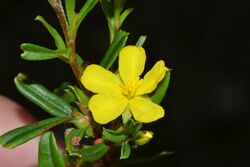Biology:Hibbertia racemosa
| Stalked guinea flower | |
|---|---|

| |
| Hibbertia racemosa in Kenwick Wetlands | |
| Scientific classification | |
| Kingdom: | Plantae |
| Clade: | Tracheophytes |
| Clade: | Angiosperms |
| Clade: | Eudicots |
| Order: | Dilleniales |
| Family: | Dilleniaceae |
| Genus: | Hibbertia |
| Species: | H. racemosa
|
| Binomial name | |
| Hibbertia racemosa (Endl.) Gilg[1]
| |
| Synonyms[1] | |
| |
Hibbertia racemosa, commonly known as stalked guinea flower,[2] is a species of flowering plant in the family Dilleniaceae and is endemic to the south-west of Western Australia. It is an erect or ascending, spreading shrub that typically grows to a height of 10–75 cm (3.9–29.5 in) and produces yellow flowers between July and December.[2]
This species was first formally described in 1837 by Stephan Endlicher who gave it the name Candollea racemosa in the journal Enumeratio plantarum quas in Novae Hollandiae ora austro-occidentali ad fluvium Cygnorum et in sinu Regis Georgii collegit Carolus Liber Baro de Hügel from specimens collected near the Swan River at Fremantle.[3][4] In 1893, Ernest Friedrich Gilg changed the name to Hibbertia racemosa.[5] The specific epithet (racemosa) means "racemose".[6]
Hibbertia quadricolor grows on coastal dunes and plains in the Carnarvon, Esperance Plains, Geraldton Sandplains, Jarrah Forest, Mallee, Swan Coastal Plain, Warren and Yalgoo biogeographic regions of south-western Western Australia.[2]
See also
References
- ↑ 1.0 1.1 "Hibbertia racemosa". Australian Plant Census. https://biodiversity.org.au/nsl/services/apc-format/display/90629.
- ↑ 2.0 2.1 2.2 "Hibbertia racemosa". FloraBase. Western Australian Government Department of Parks and Wildlife. https://florabase.dpaw.wa.gov.au/browse/profile/5161.
- ↑ "Candollea racemosa". APNI. https://id.biodiversity.org.au/instance/apni/536273.
- ↑ Endlicher, Stephan (1837). "Dilleniaceae". Enumeratio plantarum quas in Novae Hollandiae ora austro-occidentali ad fluvium Cygnorum et in Sinu Regis Georgii collegit Carolus liber baro de Hügel: 2–3. https://babel.hathitrust.org/cgi/pt?id=chi.64405481&view=1up&seq=12. Retrieved 3 September 2021.
- ↑ "Hibbertia racemosa". APNI. https://id.biodiversity.org.au/instance/apni/512317.
- ↑ Sharr, Francis Aubi; George, Alex (2019). Western Australian Plant Names and Their Meanings (3rd ed.). Kardinya, WA: Four Gables Press. p. 291. ISBN 9780958034180.
Wikidata ☰ Q17395407 entry
 |

